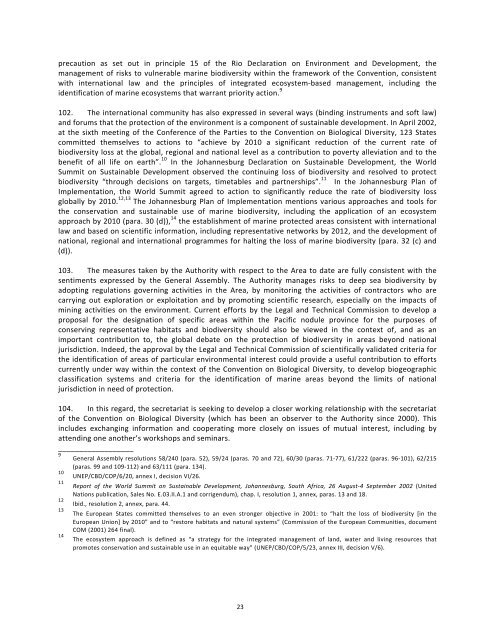Selected Decisions and Documents - International Seabed Authority
Selected Decisions and Documents - International Seabed Authority
Selected Decisions and Documents - International Seabed Authority
Create successful ePaper yourself
Turn your PDF publications into a flip-book with our unique Google optimized e-Paper software.
precaution as set out in principle 15 of the Rio Declaration on Environment <strong>and</strong> Development, the<br />
management of risks to vulnerable marine biodiversity within the framework of the Convention, consistent<br />
with international law <strong>and</strong> the principles of integrated ecosystem‐based management, including the<br />
identification of marine ecosystems that warrant priority action. 9<br />
102. The international community has also expressed in several ways (binding instruments <strong>and</strong> soft law)<br />
<strong>and</strong> forums that the protection of the environment is a component of sustainable development. In April 2002,<br />
at the sixth meeting of the Conference of the Parties to the Convention on Biological Diversity, 123 States<br />
committed themselves to actions to “achieve by 2010 a significant reduction of the current rate of<br />
biodiversity loss at the global, regional <strong>and</strong> national level as a contribution to poverty alleviation <strong>and</strong> to the<br />
benefit of all life on earth”. 10 In the Johannesburg Declaration on Sustainable Development, the World<br />
Summit on Sustainable Development observed the continuing loss of biodiversity <strong>and</strong> resolved to protect<br />
biodiversity “through decisions on targets, timetables <strong>and</strong> partnerships”. 11 In the Johannesburg Plan of<br />
Implementation, the World Summit agreed to action to significantly reduce the rate of biodiversity loss<br />
globally by 2010. 12,13 The Johannesburg Plan of Implementation mentions various approaches <strong>and</strong> tools for<br />
the conservation <strong>and</strong> sustainable use of marine biodiversity, including the application of an ecosystem<br />
approach by 2010 (para. 30 (d)), 14 the establishment of marine protected areas consistent with international<br />
law <strong>and</strong> based on scientific information, including representative networks by 2012, <strong>and</strong> the development of<br />
national, regional <strong>and</strong> international programmes for halting the loss of marine biodiversity (para. 32 (c) <strong>and</strong><br />
(d)).<br />
103. The measures taken by the <strong>Authority</strong> with respect to the Area to date are fully consistent with the<br />
sentiments expressed by the General Assembly. The <strong>Authority</strong> manages risks to deep sea biodiversity by<br />
adopting regulations governing activities in the Area, by monitoring the activities of contractors who are<br />
carrying out exploration or exploitation <strong>and</strong> by promoting scientific research, especially on the impacts of<br />
mining activities on the environment. Current efforts by the Legal <strong>and</strong> Technical Commission to develop a<br />
proposal for the designation of specific areas within the Pacific nodule province for the purposes of<br />
conserving representative habitats <strong>and</strong> biodiversity should also be viewed in the context of, <strong>and</strong> as an<br />
important contribution to, the global debate on the protection of biodiversity in areas beyond national<br />
jurisdiction. Indeed, the approval by the Legal <strong>and</strong> Technical Commission of scientifically validated criteria for<br />
the identification of areas of particular environmental interest could provide a useful contribution to efforts<br />
currently under way within the context of the Convention on Biological Diversity, to develop biogeographic<br />
classification systems <strong>and</strong> criteria for the identification of marine areas beyond the limits of national<br />
jurisdiction in need of protection.<br />
104. In this regard, the secretariat is seeking to develop a closer working relationship with the secretariat<br />
of the Convention on Biological Diversity (which has been an observer to the <strong>Authority</strong> since 2000). This<br />
includes exchanging information <strong>and</strong> cooperating more closely on issues of mutual interest, including by<br />
attending one another’s workshops <strong>and</strong> seminars.<br />
__________________<br />
9<br />
General Assembly resolutions 58/240 (para. 52), 59/24 (paras. 70 <strong>and</strong> 72), 60/30 (paras. 71‐77), 61/222 (paras. 96‐101), 62/215<br />
(paras. 99 <strong>and</strong> 109‐112) <strong>and</strong> 63/111 (para. 134).<br />
10<br />
UNEP/CBD/COP/6/20, annex I, decision VI/26.<br />
11<br />
Report of the World Summit on Sustainable Development, Johannesburg, South Africa, 26 August‐4 September 2002 (United<br />
Nations publication, Sales No. E.03.II.A.1 <strong>and</strong> corrigendum), chap. I, resolution 1, annex, paras. 13 <strong>and</strong> 18.<br />
12<br />
Ibid., resolution 2, annex, para. 44.<br />
13<br />
The European States committed themselves to an even stronger objective in 2001: to “halt the loss of biodiversity [in the<br />
European Union] by 2010” <strong>and</strong> to “restore habitats <strong>and</strong> natural systems” (Commission of the European Communities, document<br />
COM (2001) 264 final).<br />
14<br />
The ecosystem approach is defined as “a strategy for the integrated management of l<strong>and</strong>, water <strong>and</strong> living resources that<br />
promotes conservation <strong>and</strong> sustainable use in an equitable way” (UNEP/CBD/COP/5/23, annex III, decision V/6).<br />
23
















